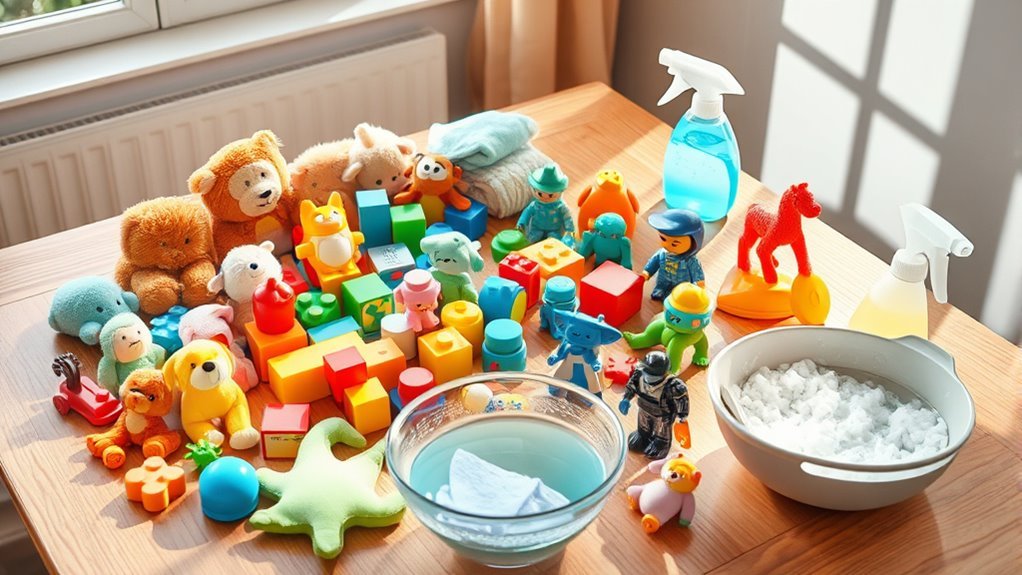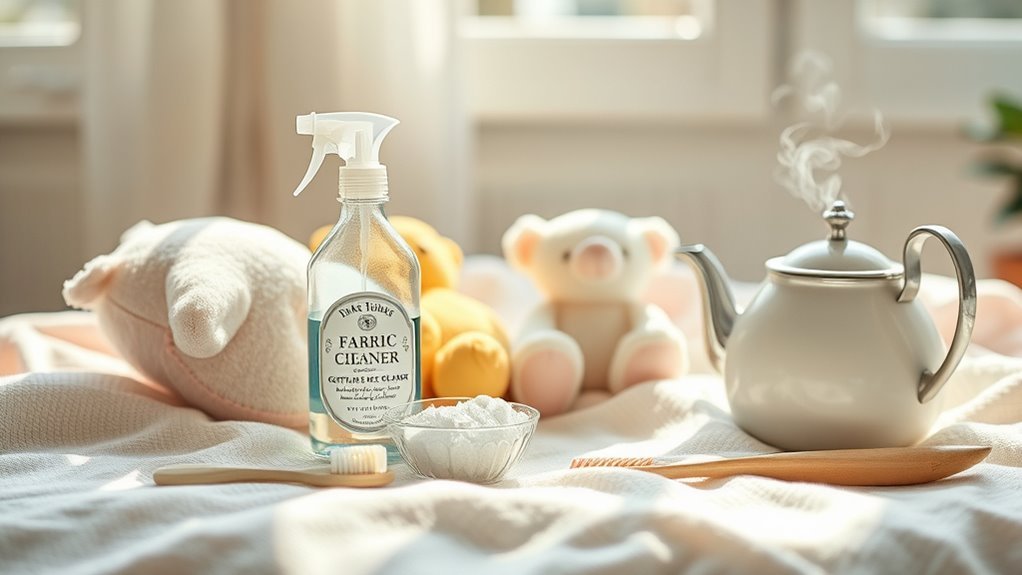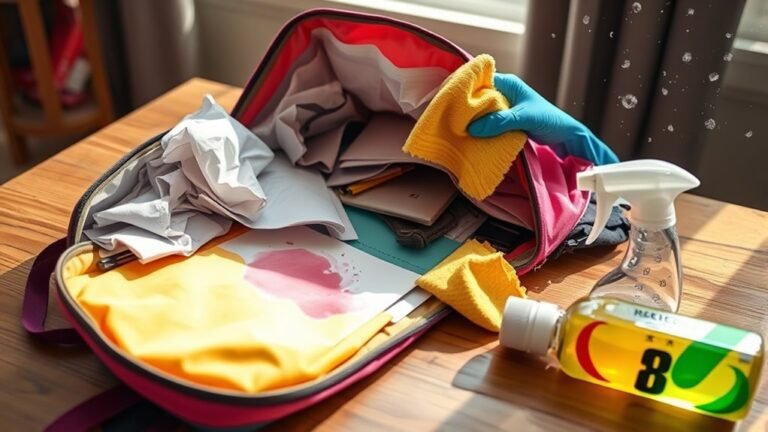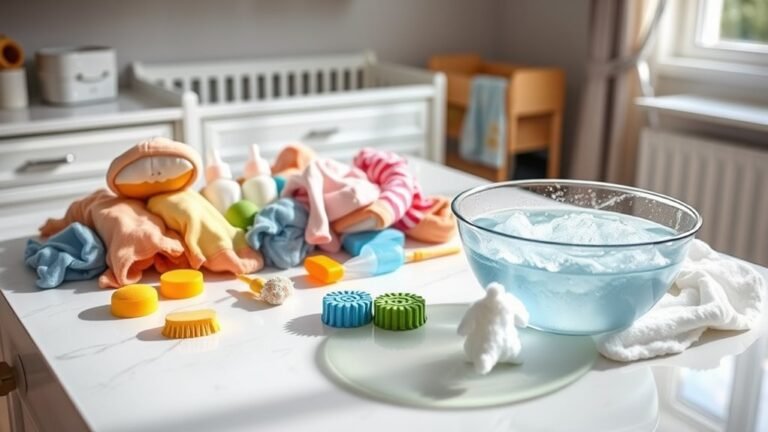How to Clean and Deodorize Your Toys
To clean and deodorize your toys, first identify their material—plastic, fabric, wood, or electronic—since each needs specific care. Use mild soap and warm water for plastic and rubber, spot clean fabric with gentle detergent, and treat wooden toys with vinegar and baking soda to remove odors. For electronics, wipe gently with a damp cloth and disinfectant wipes. Afterward, air dry toys thoroughly to prevent odor buildup. With the right methods, you’ll keep your toys fresh and safe—there’s more to explore on proper techniques.
Identifying Different Types of Toys for Cleaning

When preparing to clean toys, the first step is to identify their materials and construction, as this determines the appropriate cleaning method. You’ll want to carefully examine whether the toys are made of plastic, fabric, wood, or electronic components. Educational toys often combine several materials, requiring distinct cleaning approaches. Sensory toys, designed to stimulate touch or sound, may have delicate surfaces or internal mechanisms that need gentle handling. Check for manufacturer labels or instructions to guide your process. Recognizing these differences guarantees you avoid damage and maintain the toys’ functionality. By methodically categorizing each toy, you can tailor your cleaning strategy precisely, preserving safety and longevity while enjoying the freedom to keep your child’s playthings fresh and hygienic.
Essential Cleaning Supplies You’ll Need
To clean and deodorize toys effectively, you’ll need specific tools like soft brushes and microfiber cloths to avoid damage. Choosing safe cleaning solutions, such as mild soap or vinegar diluted with water, guarantees no harmful residues remain. Finally, proper drying and storage methods will keep toys fresh and ready for use.
Must-Have Cleaning Tools
A reliable set of cleaning tools is essential for effectively removing dirt and odors from toys without causing damage. To maintain your toys’ integrity while freeing them from grime, you’ll need the right equipment. Here are three must-have tools:
- Must have brushes: Opt for soft-bristled brushes that reach crevices without scratching surfaces. They’re perfect for intricate parts.
- Microfiber cloths: These trap dust and moisture efficiently without leaving lint behind, making them ideal for wiping down delicate toys.
- Small sponges or foam applicators: Useful for applying cleaning solutions gently and evenly on larger or textured surfaces.
Equipping yourself with these tools guarantees you clean methodically and safely, preserving your toys’ quality and extending their lifespan while enjoying the freedom of a fresh, odor-free collection.
Safe Cleaning Solutions
Choosing safe cleaning solutions is essential for protecting both the toys and the health of those who use them. Start by selecting eco friendly solutions that avoid harsh chemicals, ensuring safety without compromising effectiveness. Simple homemade cleaners, such as a mixture of white vinegar and water or mild dish soap diluted in warm water, work well for most toys. These options sanitize without leaving harmful residues. Avoid bleach or strong detergents unless specified safe for the toy’s material. Always test your chosen solution on a small, inconspicuous area first. Additionally, opt for alcohol-free wipes or sprays when convenience calls for quick cleaning. By prioritizing these careful choices, you maintain your toys’ integrity and create a healthy environment, giving you freedom from worry during playtime.
Storage and Drying Tips
While proper cleaning is essential, ensuring your toys dry thoroughly and are stored correctly is just as important to prevent mold, mildew, and damage. To master storage and drying, focus on these key steps:
- Effective Drying Techniques: After washing, pat toys with a clean towel and air dry them completely in a well-ventilated space. Avoid direct sunlight for sensitive materials to prevent deterioration.
- Optimal Storage Solutions: Use breathable containers or mesh bags to store toys, allowing airflow and reducing moisture buildup. Avoid airtight plastic bins unless the toy is fully dry.
- Regular Inspection: Periodically check stored toys for any signs of mold or damage, and re-clean as necessary to maintain freshness and longevity.
Following these precise methods guarantees your toys stay clean, dry, and ready for use—giving you the freedom to enjoy them without worry.
How to Safely Clean Plastic and Rubber Toys
Plastic and rubber toys can harbor dirt, germs, and odors, so it’s important to clean them thoroughly without causing damage. Start by considering toy material considerations—check labels for any specific cleaning instructions. Generally, you can wash these toys with warm, soapy water using a mild detergent. Avoid harsh chemicals or abrasive scrubbers that might degrade the surface. For toys with electronic parts, wipe carefully with a damp cloth instead. Follow cleaning frequency guidelines by washing frequently used toys weekly to maintain hygiene, while less-used items can be cleaned monthly. After washing, rinse thoroughly and dry completely to prevent mold growth. By methodically adhering to these steps, you guarantee your plastic and rubber toys remain safe, clean, and odor-free without compromising their integrity or your freedom to enjoy them.
Cleaning Fabric and Stuffed Toys Without Damage

Cleaning fabric and stuffed toys requires a different approach since water and detergents can affect their texture and stuffing. To maintain ideal fabric care and protect delicate toy materials, follow these steps carefully:
- Check Labels: Always read the manufacturer’s instructions for specific fabric care guidelines and recommended cleaning methods.
- Spot Clean First: Use a mild detergent diluted in water and apply gently with a soft cloth to remove stains without soaking the toy.
- Air Dry Thoroughly: Avoid heat sources; instead, let toys dry naturally to prevent shrinking or damage to stuffing and fabric fibers.
Deodorizing Wooden Toys Naturally
To deodorize wooden toys naturally, start by preparing a gentle vinegar cleaning solution that neutralizes odors without damaging the wood. You can then apply baking soda directly to absorb lingering smells, leaving it on for at least 15 minutes before wiping it off. Finally, add a few drops of essential oils like lavender or tea tree oil to enhance freshness and provide antibacterial benefits.
Essential Oils Benefits
One effective way you can naturally deodorize wooden toys is by using essential oils, which offer both antibacterial properties and pleasant scents without harsh chemicals. Incorporating essential oil blends lets you tailor the aroma while enjoying aromatherapy benefits that enhance your environment’s freshness. To do this methodically:
- Choose oils like lavender, lemon, or tea tree for their proven antibacterial and deodorizing effects.
- Dilute a few drops in water or a carrier oil to prevent wood damage.
- Apply gently with a soft cloth, allowing the wood to absorb the blend and dry completely.
This approach frees you from synthetic fragrances while maintaining the toys’ integrity, offering a safe, natural way to refresh wooden toys and embrace a cleaner, freer lifestyle.
Vinegar Cleaning Solution
Besides using essential oils, vinegar offers a powerful, natural alternative to deodorize wooden toys without introducing synthetic chemicals. To harness vinegar benefits effectively, mix one part distilled white vinegar with three parts water—these vinegar proportions guarantee a balanced solution that’s strong enough to neutralize odors but gentle on wood. Apply the mixture using a soft cloth, wiping each wooden toy thoroughly. Avoid soaking to prevent warping. After application, let toys air dry completely in a well-ventilated area. This method not only deodorizes but also helps inhibit bacterial growth naturally. By choosing vinegar, you maintain freedom from harsh chemicals while preserving the integrity and safety of your wooden toys, making this approach both practical and eco-friendly.
Baking Soda Application
Three simple steps will help you deodorize wooden toys naturally using baking soda. First, sprinkle a generous layer of baking soda over the toy’s surface, ensuring you cover every nook. Second, let the baking soda sit for at least an hour; this allows it to absorb odors effectively without damaging the wood. Third, gently brush off the baking soda with a soft cloth or vacuum it using a brush attachment to avoid scratching. This method harnesses baking soda’s natural odor removal properties, freeing your toys from unwanted smells without harsh chemicals. By following these steps, you maintain the integrity of wooden toys while achieving fresh, clean results—giving you the freedom to enjoy safe, naturally deodorized playthings every time.
Using Vinegar and Baking Soda for Toy Cleaning
A simple combination of vinegar and baking soda offers an effective, natural way to clean and deodorize toys without harsh chemicals. You’ll appreciate vinegar benefits like its antibacterial properties and ability to neutralize odors, while baking soda uses include gentle abrasion and odor absorption. Here’s how to use them:
| Step | Ingredient | Purpose |
|---|---|---|
| 1 | Baking Soda | Sprinkle on toy surface |
| 2 | Vinegar | Spray or dab to activate fizz |
| 3 | Cloth or brush | Scrub gently |
| 4 | Warm water | Rinse thoroughly |
| 5 | Air dry | guarantee complete drying |
This method frees you from chemicals, giving you a reliable, eco-friendly clean that respects both your toys and your values.
Tips for Sanitizing Electronic Toys

When sanitizing electronic toys, you’ll want to avoid excess moisture by using lightly dampened cloths with gentle cleaners. Focus on wiping down all surfaces thoroughly to remove germs and odors without damaging the internal components. Using disinfectant wipes designed for electronics can effectively deodorize while keeping your toys safe.
Safe Cleaning Techniques
Sanitizing electronic toys requires careful attention to avoid damage while ensuring cleanliness. To keep your kids safe and maintain the toy’s functionality, follow these safe cleaning techniques:
- Use eco friendly options like diluted vinegar or child safe products specifically designed for electronics. Avoid harsh chemicals that can corrode surfaces or seep inside.
- Disconnect batteries or power sources before cleaning to prevent short circuits or electrical hazards. Never submerge electronic toys in water.
- Apply cleaning solutions with a soft cloth or cotton swab, focusing on crevices and buttons. Allow the toy to air dry completely before reassembling or powering on.
Effective Deodorizing Methods
Although electronic toys require careful cleaning to avoid damage, you can still effectively eliminate odors by using gentle, non-invasive deodorizing methods. Start by unplugging or removing batteries to prevent electrical issues. Use a microfiber cloth lightly dampened with a mixture of water and mild vinegar—this natural remedy neutralizes odors without harming components. Avoid soaking or spraying liquids directly onto the toy. For added freshness, apply a small amount of scented sprays designed specifically for electronics; these won’t leave residue or cause corrosion. Alternatively, place the toy in a sealed container with baking soda or activated charcoal for several hours to absorb lingering smells naturally. By following these steps methodically, you maintain your toy’s functionality while restoring a clean, odor-free experience.
Removing Stains and Sticky Residue From Toys
Since stains and sticky residue can build up quickly on toys, you’ll want to tackle them promptly to prevent permanent damage. Start by identifying the type of stain to choose the right approach. For effective stain removal and eliminating sticky residue, follow these steps:
- Gentle Cleaning: Use warm water with mild soap and a soft cloth or toothbrush to gently scrub the affected area, loosening residue without damaging the toy.
- Targeted Solvents: For tougher sticky residue, apply a small amount of rubbing alcohol or vinegar on a cotton swab, testing first on a hidden spot to ascertain no discoloration.
- Rinse Thoroughly: After removing stains and residue, rinse the toy completely with clean water to remove any cleaning agent, preventing further buildup.
Drying and Storing Toys to Prevent Odors
To keep toys fresh and odor-free, you’ll need to dry them completely before storing. Start by gently patting toys with a clean towel to remove excess moisture. Then, use air drying as your primary drying method—place toys on a well-ventilated surface away from direct sunlight, which can degrade materials. For faster results, consider using a fan to circulate air around them. Once dry, select storage solutions that promote airflow, like mesh bags or ventilated containers, to prevent moisture buildup. Avoid airtight boxes unless toys are fully dry, as trapped humidity breeds odors. Store toys in a cool, dry place to maintain freshness. By following these precise drying methods and smart storage solutions, you’ll keep your toys odorless and ready for use whenever freedom calls.
Regular Maintenance Tips to Keep Toys Fresh
When you want to keep toys fresh over time, regular maintenance is key to preventing buildup of dirt, grime, and odors. Start by scheduling regular inspections to identify wear, stains, or unpleasant smells early. This proactive approach lets you address issues before they escalate. Next, implement a toy rotation system. By cycling toys in and out of use, you reduce constant exposure to dirt and moisture, allowing each toy time to air out and maintain freshness. Finally, clean toys promptly after use, especially those prone to grime buildup. This systematic routine guarantees toys stay hygienic and odor-free, giving you the freedom to enjoy them without worry. By following these three steps—1) regular inspections, 2) toy rotation, and 3) timely cleaning—you’ll maintain freshness efficiently and effectively.
Frequently Asked Questions
Can I Use Bleach to Clean My Children’s Toys Safely?
Back in the days of musketeers, bleach was a rare elixir, but today, you’d want to be cautious using it on your children’s toys. Bleach can be harsh and unsafe if not diluted properly. Instead, consider bleach alternatives like vinegar or baking soda for safe cleaning. These options effectively sanitize without harsh chemicals, letting you maintain freedom in your choices while ensuring your kids’ toys stay clean and safe for play.
How Often Should I Deep Clean My Child’s Outdoor Toys?
You should deep clean your child’s outdoor toys at least once every season to guarantee proper outdoor toy maintenance. Seasonal cleaning helps remove dirt, mold, and bacteria buildup that can occur with exposure to weather. Before each season starts, scrub toys with a gentle detergent and rinse thoroughly. This methodical approach keeps toys safe, fresh, and ready for play, giving you peace of mind while letting your child enjoy their freedom outdoors.
Are There Any Toys That Should Never Be Cleaned With Water?
Like walking on thin ice, you need to be cautious with water sensitive toys—they shouldn’t get wet. Toys made of electronics, certain stuffed animals with delicate stuffing, or wooden toys with non-waterproof finishes can be damaged by water. Instead, use gentle cleaning materials like a dry cloth, mild disinfectant wipes, or specialized cleaners. Always check manufacturer guidelines to preserve your child’s favorites while keeping them safe and fresh.
What Are the Best Ways to Clean Toys With Battery Compartments?
When cleaning toys with battery compartments, start by removing the batteries to prevent damage. Use toy cleaning solutions that are gentle and avoid moisture near the compartment. Wipe the exterior with a damp cloth, steering clear of openings. For battery maintenance tips, check for corrosion and clean contacts with a cotton swab dipped in vinegar or baking soda solution. Let everything dry completely before reinserting batteries, ensuring your toy stays safe and functional.
Can Essential Oils Be Used to Deodorize Kids’ Toys?
Imagine essential oils as tiny bursts of nature’s perfume, ready to freshen any space. You can use them to deodorize kids’ toys, but safety is key. Essential oil benefits include natural antibacterial properties and pleasant scents, yet you should always dilute oils with water or a mild carrier before applying. Avoid direct contact with plastic parts and keep usage minimal to guarantee the toys stay safe for your child’s freedom to play.






